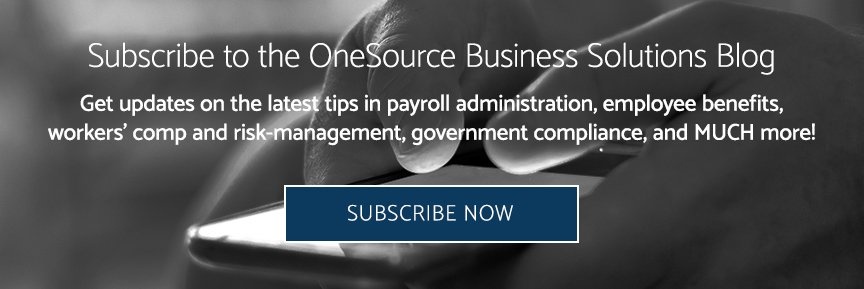OneSource Business Solutions Blog
How to Avoid Employee Burnout

Employee burnout has been around a while, but it is only recently being recognized as a real problem for companies and employees. Although many see overworking as a sign of a hard worker or ambitious talent, it negatively impacts employees enough to decrease productivity in the workplace and lead to absenteeism, presenteeism, increased turnover, etc. So, while it may seem essential to meeting deadlines, it is actually more damaging than good.
According to a Deloitte survey, 91% of respondents say having an unmanageable amount of stress or frustration negatively impacts the quality of their work. Nearly 70% of professionals feel their employers are not doing enough to prevent or alleviate burnout within their organization. This isn’t a problem that only affects a few, either. They also found that 77% of respondents say they have experienced employee burnout at their current job, with more than half saying it happened more than once.
With that being said, burnout can be avoided by focusing on what matters most to employees, learning more about employee burnout, and reducing it in the workplace.
What is employee burnout?
Employee burnout refers to a significant amount of job stress put on an individual, causing them to feel physically and emotionally drained. It can be caused by a number of things in the workplace: lack of knowledge and tools needed to complete your job, negative workplace environment, feelings of isolation in the office, an imbalance between work and personal life, and too much overtime.
When these problems go on unaddressed for a substantial period of time, it leads to the consequences mentioned above because employees are having such a hard time recovering and are likely to need more time away or may choose to leave that environment altogether.
Identifying the signs is an essential step in managing burnout among employees and lowering your turnover. According to Mayo Clinic, an employee may be burnt out if they are:
- Being cynical or critical
- Having trouble getting started at work
- Irritable or impatient with coworkers, customers, or clients
- Inconsistent in productivity
- Lack of concentration or satisfaction in achievement
- Using food, alcohol, or drugs to feel better
- Changing in sleep habits
- Have physical complaints like unexplained headaches, stomach problems, etc.
6 Ways to Reduce Employee Burnout
The Mental Health Foundation reports that “there is strong evidence that workplaces with high levels of mental wellbeing are more productive. [In fact,] addressing wellbeing at work increases productivity by as much as 12%.”
Here’s what you can do to reduce employee burnout and maintain or increase productivity in your business.
Improve Work-Life Balance
Work-life balance refers to the right balance between the amount of time an employee spends at work and the amount of time they spend at home doing anything but work. Unfortunately, the balance is often interrupted by employees taking their work home with them, not taking vacations, and working overtime at the office regularly.
Some great ways to help your employees improve their work-life balance include offering flexible hours and remote work, encouraging more breaks between assignments, looking for signs of too much overtime, and teaching your employees about burnout and the importance of taking time for themselves and balancing work and life.
Visible Career Progression
Ensuring employees understand how they can grow into new jobs or new opportunities is another important step to reducing employee burnout and its consequences. This is because employees that don’t know or understand their potential career progress are more likely to think they are in a dead-end career than ones who know their hard work will pay off down the road.
Career progression has a host of benefits, but you will notice most of all that your employee’s productivity and satisfaction will go up, and their stress will go down. You will also be able to fill in job position gaps within the company by encouraging knowledge sharing that opens up new opportunities for employees that didn’t know they could qualify for or be interested in them.
Breaks Throughout the Day
Giving, and in some cases demanding, breaks throughout the day is essential because it allows employees to reset and bring more focus to their work when they come back. Constant work for eight or more hours can drain people mentally and physically, whereas breaks in between can keep them charged and productive. It should also be noted that you should also allow employees to do what they want during the break, as they will know what will benefit them most, better than anyone else.
Many experts even suggest that you consider giving them the chance to have short naps to re-energize themselves or taking walks around the area to reduce the mental fatigue of being in an office.
Keep Lines of Communication Open
Enabling employees to come to the employer with their problems is extremely important for keeping the work environment positive and inclusive. This will help avoid office conflicts that can be preventable, encourage more productivity, and ensure that everyone is on the same page about goals and the steps needed to meet them.
Note that open communication takes active participation by leadership to ensure employees understand that they can talk to their boss without repercussions.
Focus on Employee Engagement
Better employee engagement will lead to much more success in individual and team performances because employees will feel more valued and purpose-driven. Engaged employees are also much less likely to turnover because they enjoy doing their job and genuinely believe in the betterment of the business. Consider measuring engagement through employee surveys to ensure everyone is satisfied.
Following the results, you can improve engagement by improving workplace culture. This means prioritizing transparency, celebrating employees and their accomplishments, providing beneficial and respectful feedback, and hiring employees that align with your culture.
Outsource HR Functions
Outsourcing HR functions can make all the difference for your business and employees. By freeing up HR’s time, you reduce their administrative burdens, which gives them time to focus on ways to reduce turnover. If you partner with a Professional Employer Organization (PEO), you also gain access to their benefits masterplan, which is negotiated at scale by experts. This means Fortune 500 benefits at Fortune 500 prices.
This is important because the impact of strengthening your employee benefits on your staff will increase loyalty to your company. Not only are they more likely to feel valued enough to stay with the company for years to come, but they will also be more inclined to recommend open positions to qualified friends and family.
Reducing Employee Burnout Requires Leadership
Reducing employee burnout begins with employers making sure the above measures are implemented into the daily lives of their employees, from top to bottom. It requires that same leadership to maintain a healthy and positive environment, so employees know they are valued and appreciated for the work they put into the company’s success. This, in turn, will significantly reduce burnout and increase productivity.
Recent Posts
Posts by Topic
- HR Outsourcing (37)
- Employee Benefits (14)
- Payroll & HR Administration (5)
- Strategic Planning & Research (5)
- Company Culture (4)
- HR Compliance (4)
- Industry – Professional Services (4)
- PEO (4)
- Workers’ Comp (4)
- Employee Turnover (3)
- OneSource PEO Company News (3)
- performance management (2)
- Navigating COVID-19 (1)
- manufacturing industry (1)
